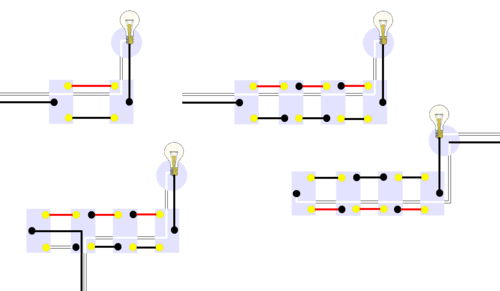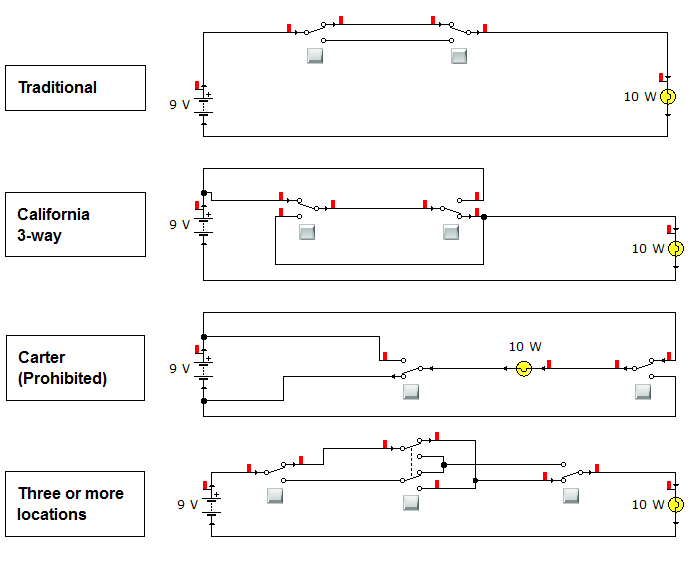Multiway switching
In building wiring, multiway switching is the interconnection of two or more electrical switches to control an electrical load (often, but not always, lighting) from more than one location. For example, this allows lighting in a hallway, stairwell, or large room to be controlled from multiple locations. While a "normal" light switch needs to be only a Single Pole, Single Throw (SPST) switch, multiway switching requires the use of switches that have one or more additional contacts and two or more wires must be run between the switches. When the load is controlled from only two points, Single Pole, Double Throw (SPDT) switches are used.
In alternative designs, low-voltage relay or electronic controls can be used to switch electrical loads, sometimes without the extra power wires.
Three-way and four-way
This article follows American usage. Readers in the most other countries should read "two-way" for the American "three-way" and "intermediate" or "crossover" switch for the American "four-way".[1][2] [3]
The controlled load is often a lamp, but multiway switching is used to control other electrical loads, such as an electrical outlet, fans, pumps, heaters, or other appliances. The electrical load may be permanently hard-wired, or plugged into a switched receptacle.
Three-way and four-way switches make it possible to control a light from multiple locations, such as the top and bottom of a stairway, either end of a long hallway, or multiple doorways into a large room. These switches appear externally similar to Single Pole, Single Throw (SPST) switches, but have extra connections which allow a circuit to be controlled from multiple locations. Toggling the switch disconnects one "traveler" terminal and connects the other.
Electrically, a "3-way" switch is a Single-Pole, Double-Throw (SPDT) switch. By correctly connecting two of these switches together, toggling either switch changes the state of the load from off to on, or on to off. The switches may be arranged so that they are in the same orientation for off, and contrasting orientations for on.
A "4-way" (intermediate) switch is a purpose built Double Pole, Double Throw (DPDT) switch, internally wired in manufacture to reverse the connections between the input and output and having only four external terminals. This switch has two pairs of "traveler" terminals that it connects either straight through, or crossed over (transposed, or swapped). An intermediate switch can, however, be implemented by adding appropriate external wiring to an ordinary (six terminal) DPDT switch.
By connecting one or more 4-way (intermediate) switches in-line, with 3-way switches at either end, the load can be controlled from three or more locations. Toggling any switch changes the state of the load from off to on, or from on to off.
Number of wires
In this article, when comparing different wiring methods or systems, the focus is on the number of wires connecting the switches to each other. Usually an additional wire is present in each cable to carry an unswitched neutral or hot wire which passes through the switch mounting box, but is not normally connected to the switch. However, if the multiway switch also incorporates a pilot light or a receptacle, additional hot or neutral connections to the device may be required. By convention, a grounding (earthing) conductor for safety is not counted, but is understood to be present in all cables and conduits in modern American wiring practice.
Two locations
Switching a load on or off from two locations (for instance, turning a light on or off from either end of a flight of stairs) requires two SPDT switches. There are several basic methods or systems of wiring to achieve this.
Traveler system
The traveler system may also be called the "Common system", due to the line and load of the system being connected to the common terminal of their respective 3-way switch.
In the traveler system, the line (hot) is fed into the common terminal of one of the switches; the switches are then connected by a wire pair called "travelers" (or "strappers" in the UK), and the lamp is connected to the common of the second switch, as shown. This method requires 2 wires between the switches.
Using the traveler system, there are 4 (= 2 x 2) possible combinations of switch positions: two with the light on and two with the light off.
Off On
Alternative system

The alternative system is also known as the California 3-way or the Coast 3-way. It is a method of wiring using 3 conductors and two 3-way switches. It allows for a hot receptacle at both ends of the circuit as well as switched light outlets on both ends. Its main benefit is that it saves on conductors when the wire to the light is located near the wire from the mains, since they are both in the same switch box. It can also light a lamp (or a second lamp) that is near the second switch box without having to pass an extra wire (with the standard system, an extra wire would be needed).
The main drawback is that the alternative system is wired up to the 3-way switches in a manner that can cause confusion and mis-wiring for someone who follows the initial installer, but lacks a full understanding of multiway wiring. Even without fully understanding the wiring under either system, a handyman can safely replace a worn-out switch by carefully drawing a diagram of the existing installation, and replacing the switch on a one-for-one basis after verifying the internal connections of the old and new switch.
When wired correctly, the alternative system does not pose an electrical code violation, since the ground and neutral conductors are never switched or interrupted. While this method requires 3 wires between the switches (plus a neutral and a ground), it has the advantage of allowing loads at both ends of the switched circuit to be controlled from either end.
The alternative system joins the 3 terminals of one switch to the corresponding terminals on the other switch. The incoming power and the light are connected as shown.
The alternative system should not be confused with the obsolete Carter system, described next.
Carter system

The Carter system was a method of wiring 3-way switches in the era of early knob-and-tube wiring. This obsolete wiring method has been prohibited by the National Electrical Code since 1923 (actual: see NEC Article 404.2 [4]), even in new knob-and-tube installations which are still permitted under certain circumstances. This wiring system may still be encountered in older "grandfathered" electrical installations.
In the Carter system, the incoming live (energized) and neutral wires were connected to the traveler screws of both 3-way switches, and the lamp was connected between the common screws of the two switches. If both switches were flipped to hot or both were flipped to neutral, the light would remain off; but if they were switched to opposite positions, the light would illuminate. The advantage of this method was that it used just one wire to the light from each switch, having a hot and neutral in both switches.
The major problem with this method is that two of the four switch combinations apply the energized wire to the outer shell of an Edison screw light socket, presenting a shock hazard. As the shell may be energized, even with the light switched off, this poses a risk when changing a bulb. Because of this problem, this method is prohibited in modern building wiring.
More than two locations
For more than two locations, two of the interconnecting wires must be passed through an intermediate switch, wired to swap or transpose the pair. Any number of intermediate switches can be inserted, allowing for any number of locations. This requires two wires along the sequence of switches.
Traveler system
Using 3 switches, there are 8 (= 2 x 2 x 2) possible combinations of switch positions: four with the light on and four with the light off. Note that these diagrams also use the American electrical wiring names.
Off On
As mentioned above, the above circuit can be extended by using multiple 4-way switches between the 3-way switches to extend switching ability to any number of locations.
Summary
Wiring guidelines

Switches built to North American standards identify the terminals by color-coding. The common is often colored black and the pair of traveler connections often colored gold. There is no standard for indicating the terminals on 4-way switches, so they may need to be checked with a meter or a continuity tester to deduce the internal contacts.
Most electricians know these simple guidelines when wiring multiway switching.
- The lightbox always needs a neutral.
- Either one switchbox or the lightbox has hot and neutral from the mains.
- The common terminal of one 3-way switch goes to a hot from the mains, and the common terminal from the other 3-way switch goes to the light.
- The traveler terminals connect to each other at each switchbox.
- Usually a 3 conductor cable is connected between the multiway switches. A pair of conductors for travelers, and the remaining conductor for either neutral or hot conductor. This is dependent on which box the mains are in.
- Only a 2 conductor cable is needed between the light and one of the switches.
Low voltage relay switching
Systems based on relays with low-voltage control circuits permit switching the power to lighting loads from an arbitrary number of locations. For each load, a latching relay is used that mechanically maintains its on- or off-state, even if power to the building is interrupted. Mains power is wired through the relay to the load.
Instead of running mains voltage to the switches, a low voltage — typically 24 VAC — is connected to remote momentary toggle or rocker switches. The momentary switches usually have SPDT contacts in an (ON)-OFF-(ON) configuration. Pushing the switch actuator in one direction causes the relay contacts to close; pushing it in the opposite direction causes the relay contacts to open. Any number of additional rocker switches can be wired in parallel, as needed in multiple locations. An optional master control can be added that turns all lights in the facility on or off simultaneously under the control of a timer or computer.
After an initial burst of popularity in the 1960s, residential use of such relay-based low voltage systems has become rare. Equipment for new installations is not commonly carried by electrical suppliers, although it is still possible to find parts for maintaining existing installations.
Electronic remote switching
As of 2012, multiway switching in residential and commercial applications is increasingly being implemented with power line signalling techniques. These include the X10 system, available since the 1980s, and newer hybrid wired/wireless systems, such as Insteon. See home automation for more details.
Remote-control systems are increasingly used in commercial buildings as part of lighting systems under semi-automatic control, for better safety, security, and energy conservation.
References
- ↑ Usage on "Ultimate Handyman" UK website
- ↑ "DIY Howto" UK website.
- ↑ Usage on "Light wiring" UK website
- ↑ Switch Connections: (A) … Three-way and four-way switches shall be wired so that all switching is done only in the ungrounded circuit conductor … (B) Grounded Conductors. Switches or circuit breakers shall not disconnect the grounded conductor of a circuit. Switching a neutral is generally forbidden by the NEC unless the hot conductor is opened simultaneously
Further reading
| Wikimedia Commons has media related to Multiway switching diagrams. |
- Richard Day, Wiring Multi Switches, page 85 and following, in Popular Science Jan 1987, Vol. 230, No. 1 ISSN 0161-7370
- Michael Litchfield and Michael McAlister, Taunton's wiring complete: expert advice from start to finish (revised edition), Newtown CT: Taunton Press (2008), ISBN 9781600852565












